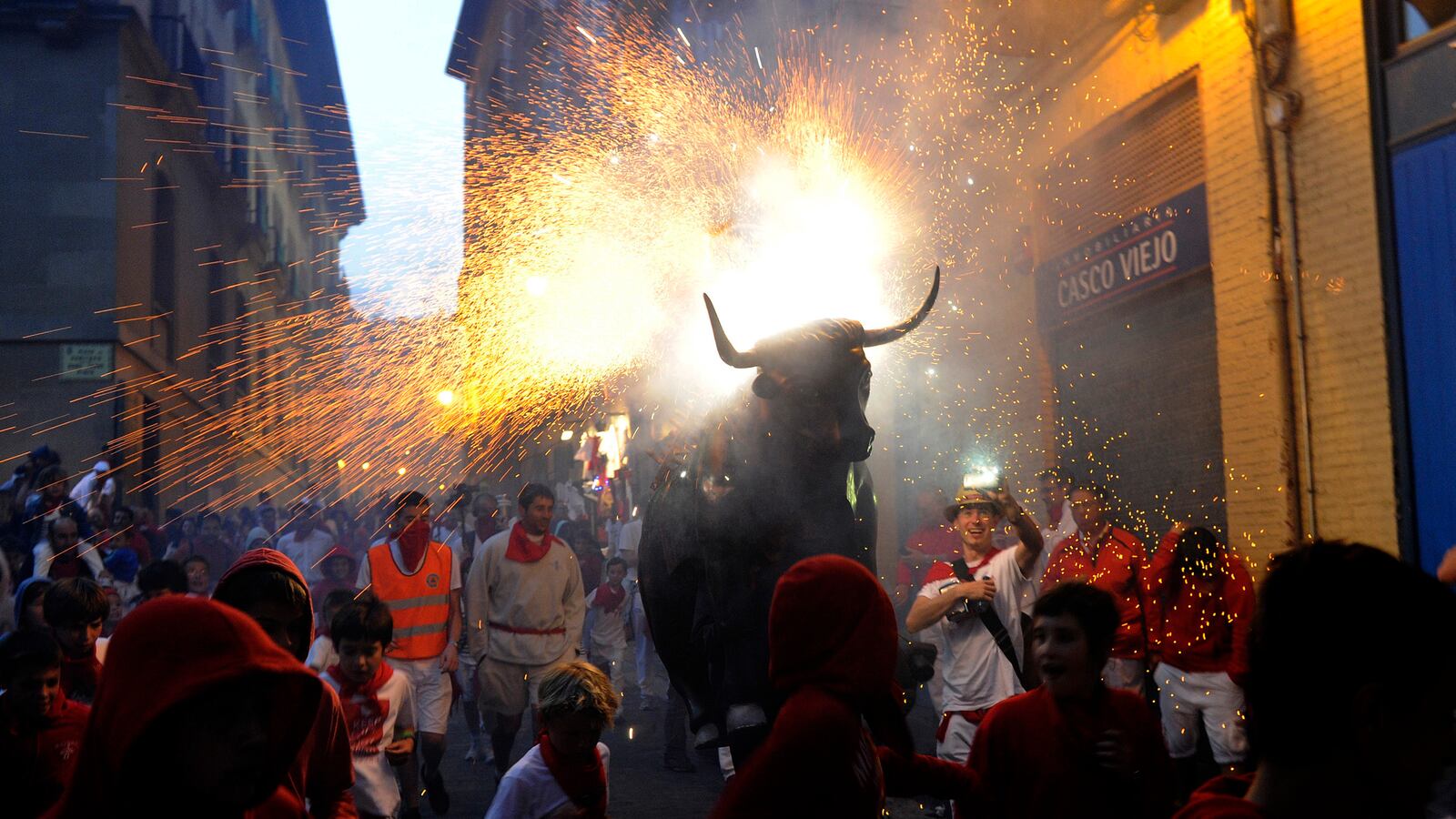Somebody should speak up for the bulls. Year after year they have to endure the torment of being required to live up to the role that Ernest Hemingway gave them. They are unleashed into the narrow streets of old Pamplona and forced to stampede, pursued by crazy guys in red scarfs.
Hemingway didn’t invent the Running of the Bulls. By the time he arrived in Pamplona in 1923 it had been going on for four centuries. But Hemingway saw something in the ritual that others had not: it was great material for a writer - two kinds of animal competing to prove which one had the larger cojones.
As a literary metaphor it not only served Hemingway well, it sustained an industry of Hemingway aficionados, a gift that went on giving, particularly to Pamplona, where many thousands of tourists arrive early in July for the San Fermin festival. Ironically, this year a co-author of a book called How to Survive the Running of the Bulls was badly gored by huge black bull.
Many years ago, when I first read Hemingway’s breakthrough novel The Sun Also Rises, I succumbed to the belief that only in Spain could a certain primitive but noble energy be tapped that made life a lot more interesting. But of course it was about more than that. There would have been no inimitable Hemingway voice without Spain. Spain provided the stage in which Hemingway’s eyes and ears were able to compose a language unique to him, where secret inner lives including his own broke into the sun and were suddenly naked.

It seemed necessary to go to the source. I left from Paris for the southwest, on the Sud Express, as Hemingway’s narrator and alter ego Jake Barnes had in The Sun Also Rises. (Regarding the cojones: Jake had none, he had been emasculated by a war injury.) With me was the young woman who would later be my wife.
This was before France had its network of high-speed trains. The Sud Express dining car served a seven-course lunch, paced gracefully to last most of the journey. As we ate, we were waiting, novel at hand, to see Hemingway’s landscape materialize. South of Bordeaux, in the last flat, forested plains before the foothills of the Pyrenees, called Les Landes, it did, as Hemingway described it: “We passed through the Landes and watched the sun set. There were wide fire gaps cut through the pines, and you could look up them like avenues and see wooded hills way off.”
We were headed to the small port of St-Jean-de-Luz in the Basque country near the Spanish border. We had to leave the Sud Express at Bayonne and took a hard-benched local to St-Jean, a place that Hemingway had greatly enjoyed.
It was Bastille Day. The Basques, proudly independent, did not follow or honor the rituals of Paris. They took the national day and shook it free of all its pieties. The whole town was in a drunken reverie, singing and dancing to brass bands with the tribal beat of the Basques. Amid this carnival we found a hotel and a bed. As we pulled back the sheets the bed was full of confetti in the Basque colors, red, white and green.
Falling readily into the embrace of the town, we never crossed the border into Spain. The beach life was relaxed and unmodish, the food and wine were a revelation – a favorite dish was langoustines and crabs on a bed of sea snails, served with the only good wine of the Pyrenees, the white Jurancon sec. We followed Hemingway’s path to the docks, where great fat Atlantic tuna were winched from the boats direct to the market.
Pamplona would have to wait. In fact, it waited a long while.
Hemingway made three consecutive trips to the San Fermin, from 1923 to 1925. By the last trip his notebooks were stuffed with the material from which he would fashion The Sun Also Rises. In 1923 he was hard-up and struggling but moving among the literary lions of Paris – Ford Madox Ford, James Joyce, Ezra Pound – and under the caring eye of Gertrude Stein and Alice B. Toxlas. It was Toxlas who recommended that he should go to Pamplona, in mountainous Navarre, more difficult to reach than the parts of Spain he already knew like Madrid and Seville.
Hemingway and his first wife Hadley went from the Basque country to Pamplona over the Pyrenees by bus. In The Sun Also Rises he writes: “In the Basque country the land all looks very rich and green and the houses and villages look well off and clean.”
There is no record of the actual route. After his third trip in 1925 Hemingway wrote to F. Scott Fitzgerald: “God it has been wonderful country. But you hate country. All right omit description of country. I wonder what your idea of heaven would be – A beautiful vacuum filled with wealthy monogamists, all powerful and members of the best families all drinking themselves to death….To me heaven would be a big bull ring with me holding two barrera seats and a trout stream outside that no one else was allowed to fish in…”
Finally, making our second attempt to reach Pamplona, we decided to try to find a route that could have been Hemingway’s.
There were clues in the novel. Jake Barnes narrates: “We all got in the car and it started up the white dusty road into Spain. For a while the country was much as it had been; then, climbing all the time, we crossed the top of the col, the road winding back and forth on itself, and then it was really Spain. There were long brown mountains and a few pines and far-off forests of beech-trees on some of the mountainsides. The road went along the summit of the col and then dropped down, and the driver had to honk, and slow up, and turn out to avoid running into two donkeys that were sleeping in the road.”
For a writer who was a master of reduction, never one to linger on the passing view, this was an unusually effulgent paragraph. But Hemingway was describing more than a journey. The car was carrying the cast of bohemians, modeled on some of his circle in Paris, who would give the novel its powerful charge of sexual ambiguity and betrayal. It was as much a passage into a new literature as it was into Spain.
We knew there was a good a modern road through a pass to Pamplona, but that had not existed in 1925. There were two other well posted roads over the mountains, but they didn’t feel right either. Then a larger-scale map revealed a twisting, narrow road up to the Col de Lizarrieta, at around 1,300 feet. We sensed that this could be “the summit of the col.”
The road certainly wound back and forth on itself, barely wide enough for our small car. There were sheer rises on one side and sheer drops on the other. Mountain sheep were everywhere, some sleeping by the road, some foraging, bells ringing from their necks as they moved.
Above the tree line was raw heathland, exposed to the north. It granted a stupendous view back to France. I could imagine the eighth-century Moors, reaching the summit and seeing Christendom stretched out before them, all green and lazy, ripe for the taking. They rode as far as Tours on the Loire until stopped by the French cavalry of Charles Martel.
On the way down into Spain the road several times broke from tree cover in valleys that were a sea of saturated emerald. Hemingway wrote of crossing a stream into a “gloomy little village.” We crossed a stream into a village of timbered white plaster houses, some with pretty wrought-iron balconies. There was a phone booth with instructions in English for making direct international calls.
This proved to be the end of the old route to Pamplona. A few miles on, a new main road was clotted with convoys of tractor-trailers. Pamplona is a vibrant modern city that takes care to preserve the traditions of Navarre culture and cuisine. But the old city, site of the bull run, has the inevitable trappings of a theme park for aficionados of the vicarious kind.
Pamplona illustrates a fundamental truth of travel: a place and a time can create both a magnetic attraction and a consequential disappointment.
The San Fermin festival was already drawing the wrong crowd while Hemingway was there. On his last trip in 1925 he was appalled to find that a trout stream where he had fished (and later used to provide Jake Barnes an epiphany) had been ruined by loggers. The idle rich had driven down from Biarritz with their uniformed chauffeurs. English was more and more heard in the cafes. Hotel rooms were scarce and tickets to the bullfights harder to get. This wasn’t a result of the Hemingway Effect – the novel wasn’t yet written. But Alice B. Toklas was later sorry she directed him there. She considered Pamplona ruined “on account of Hemingway.”
In the same way, the Florence of A Room With a View was already blighted by tourism when E.M. Forster went there at the dawn of the 20th century, and the French Riviera was no longer a backwater with quaint fishing ports when F. Scott Fitzgerald schmoozed there in the 1920s with the Beautiful People he struggled so hard to capture in Tender is The Night. Art can be an accomplice to the process of destroying Eden but is never the sole agent. It should be enough that each of these books through their genius evokes a moment and an experience that nobody can now purchase.






